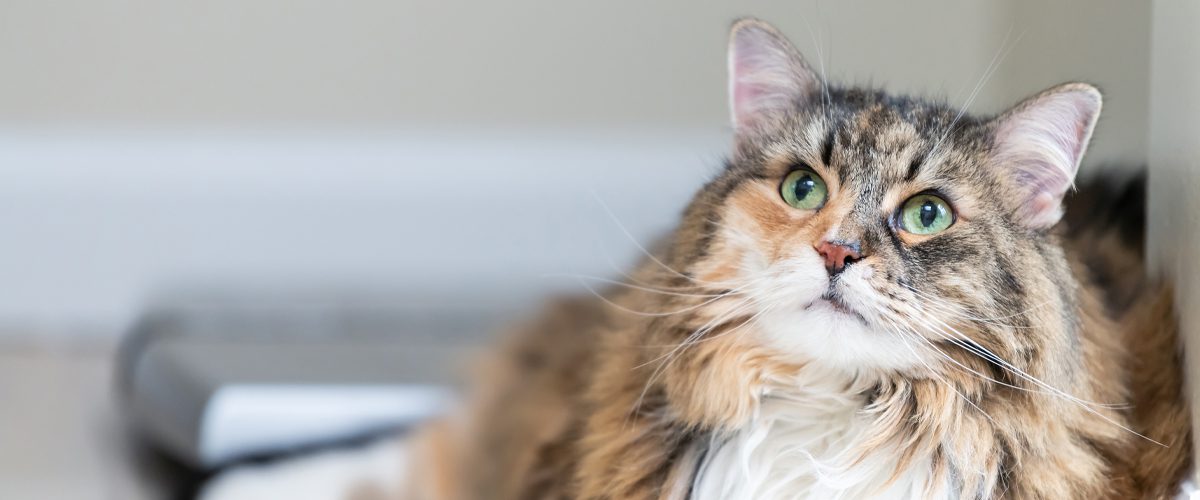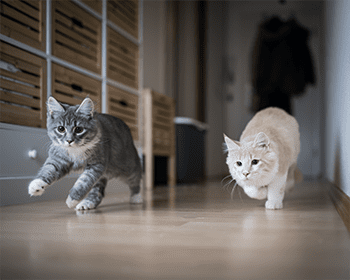A Guide to Cat Weight Loss
If your cat is feeling a little heavier than usual and you suspect they could be overweight, you might be surprised to hear that they’re not alone. In fact, an estimated 60% of pet cats are overweight or obese. And while there’s no question that your cat is adorable no matter what their size, there are some health considerations that come along with being a heavier kitty. Below, we’ll take you through what you need to know about having an overweight cat and how to encourage weight loss for them.
How to tell if your cat is overweight
How can cat owners tell if their kitty has put on a few extra pounds? For starters, feel their ribs. If your cat falls into a normal weight category, their ribcage should feel similar to the knuckles on your flat hand. If you can barely feel their ribs under their fur, it could be time for some lifestyle changes. The same goes for their spine: you should be able to lightly feel their backbone right beneath their fur, skin, and thin layer of fat.
Another way to tell if your cat is overweight is to visually look at their body. From above, you should be able to see a slight curve inwards at their waist; if they don’t have any waist definition, they could be overweight. It is worth pointing out that while looking for a tapered waist from the side is helpful with dogs, it doesn’t really apply to cats, many of whom have loose skin on their bellies. This is known as the primordial pouch and it’s perfectly normal.
Because weight isn’t the only contributing factor to overall health, a trip to the vet is a reliable way to evaluate your cat’s weight and health. If you are concerned, once your veterinarian has assessed your cat’s weight, they’ll likely recommend changes in their diet and exercise routine to help them get healthy. Implementing these recommendation
How to help your cat lose weight
Weight loss for cats doesn’t have to be overly complicated. In fact, the approaches used to help cats lose weight are quite similar to what we do as humans. Here are a few tips for supporting a healthier lifestyle for your feline friend.
Cat nutrition
When it comes to encouraging weight loss for your cat, a gradual approach is key. Sudden changes to their diet could trigger an adverse reaction. That’s why it’s important to follow feeding transition guidelines if you are switching to a new type of food. This involves gradually introducing the new food alongside your cat’s old food, mixing them together, and eventually cutting the old food out (this can take a couple of weeks).
Implementing dietary changes is also a great time to evaluate the quality of your cat’s diet. As a rule of thumb, look for a cat food recipe that is high in protein, has minimal carbs, and is made with whole foods and all natural ingredients. Meat proteins, like chicken, rabbit, turkey, or sardine, are the most important part of a cat’s diet: it gives them essential nutrients, like amino acids and taurine that they need to stay healthy, as well as L-Carnitine, which helps transform fat into energy.
If you tend to free feed your cat (i.e. leaving a bowl of food out for them to nibble at throughout the day), you can figure out how much they are eating every day by measuring the food when you fill the bowl and measuring again at the end of the day. This will give you an idea of how much your cat is currently eating, and how many calories you need to (gradually) cut from their diet. You also want to be sure your cat has access to fresh water throughout the day.
All that said, it’s always a good idea to consult your vet before putting your cat on a weight loss plan, particularly if they are considered obese.
Consistent exercise
Getting a cat to exercise is obviously a bit different than a dog. While a dog parent can simply take their dog on longer walks, a cat parent is faced with a more complex (and in some cases more stubborn) situation. Fortunately, there are ways to encourage your cat to get active.
Installing climbing spaces around your home is a great way to motivate your cat to move independently. Cats love to climb and explore new spaces, so introducing a cat tree or putting up cat shelves should encourage them to get off the couch and integrate some fun movement in their day.
Playing with your cat throughout the day is another fun strategy to help them shed some pounds. Each cat has their own preferences when it comes to toys, but generally speaking, cats enjoy playing with things that engage their predatory instincts, like jumping and pouncing. If your cat is particularly motivated by food, you can make a treasure hunt for them by hiding pieces of their food around the house, or using food puzzle toys that get your cat to work for their snack. Just make sure you account for these added calories as part of your cat’s total daily calorie consumption.
Lastly, don’t be too concerned if your cat spends most of their day snoozing: most cats only really need about 30 minutes of exercise a day, and that tends to happen in short bursts.
A healthy cat is a happy cat
There are many convincing reasons to help your cat get back to a healthy weight; not only can it help minimize the risk of certain medical conditions, but it can also improve their quality of life.
We’re here to help you feel good about the nutrition you’re supplying your cat. Our feline kibble is 100% natural, with the nutrition derived only from whole foods and all natural ingredients, nothing artificial and no synthetics. Our canned food follows the same all natural approach and is also nutrient dense and packed with moisture to keep your cat well hydrated. If you want to learn more about which Nature’s Logic recipe is best for your cat, send us a message by clicking the button below. We would love to chat!






